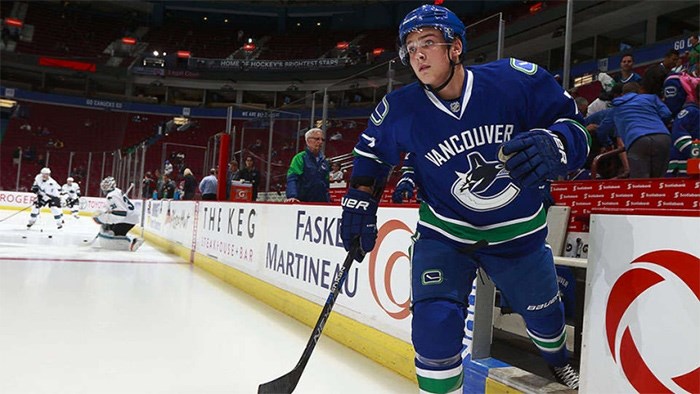
Ever since joining the Sedin line, Jake Virtanen has been on a roll. He has points in three-straight games, including two goals. More than that, he’s been constantly noticeable, creating chances and rebounds with his speed and shot, including a stunning eight-shot performance in Detroit.
Virtanen’s presence on their line seems to have reinvigorated the Sedins, who are suddenly playing with more speed and urgency than we’ve seen from them in a couple years.
For Virtanen, it’s not primarily about the offence, however. Or rather, he’s focussed on where offence begins: the defensive zone.
“The last couple games I felt really good offensively, but it all starts in the D zone,” said Virtanen heading into Thursday’s game against the Washington Capitals. “You’ve got to have a good 200-foot game and it’ll transfer over into the other zone.”
Ironically, despite saying it all starts in the defensive zone, Virtanen hasn’t. The winger hasn’t been on the ice for a single defensive zone faceoff in the last three games. Travis Green is quick to defend his winger.
“It has nothing to do with Jake, that’s for sure,” said Green. “A lot of times the other teams are putting their top lines on the ice in the offensive zone, so that has something to do with it. I like Sutter and Horvat on D zone faceoffs. It might change at home, but… it has nothing to do with Jake at all.”
It might have something to do with the Sedins themselves, who haven’t started much in the defensive zone with any of their wingers. Instead, the Sedins are being deployed primarily in the offensive zone, much as they were under Alain Vigneault, albeit in far fewer minutes.
Even if Virtanen doesn’t start his shifts in the defensive zone, it’s clear that Green has him focussing on his 200-foot game. And there’s a consensus growing among fancy stats folk that suggest zone starts don’t matter anywhere near as much as we might think.
As Micah Blake McCurdy puts it, “At season scales, for almost every regular player, zone starts don't matter.” When it comes to zone starts, even the most extreme deployment in the offensive zone or defensive zone only makes a small difference to a player’s shot attempt differential. After about 10-15 seconds, the advantage or disadvantage of an offensive zone or defensive zone faceoff disappears.
“Sutter and Bo’s line are mostly in the D zone,” says Virtanen, “but when we’re in our D zone and we’re breaking out, we’ve got to be good on the walls. The wingers have to be good on the walls and get pucks out.”
So, considering that zone starts have a minimal effect, Virtanen has been excellent defensively. His 52.7 shot attempts against per hour (CA/60) is the fourth lowest rate of shot attempts against among Canucks forwards, behind only the Sedins and Markus Granlund.
When he’s been on the ice with Henrik Sedin, that drops to 37.3 CA/60. The Canucks give up next to nothing in the defensive zone when Virtanen and the Sedins are on the ice at 5-on-5.
Part of that is Virtanen’s transition game. He’s strong along the wall and has great speed through the neutral zone, so the Canucks are able to quickly move the puck up ice.
“I think that’s definitely a big strength of mine, having that quick transition game,” said Virtanen. “The D get it up to the forwards right away, that’s part of our system. I said that from camp: Greener wants us to get that puck up and go right away and that’s helping me for sure.”
“I think the twins have helped him on the ice and probably off the ice as well, talking about the game between shifts and he’s helped them with his speed,” said Green, before being asked about Virtanen’s ice time, particularly in the third period. “I trust him in the third period. I think people make a bigger deal out of it than they have to. When you’re up 1-0 with six, seven minutes left in the game, you’re going to go with guys that are really good in their own zone.”
“I don’t go into a game sitting there saying I want to play Jake 10-12 minutes,” he added. “I coach the game the way I see it and the feel of the game and the matchup and how we’re playing, how every line’s playing, how every player is playing. I do look at the minutes in between periods, but definitely when you’re playing well, you get rewarded and that’s the way I do it.”
“I think Jake right now, he’s not playing the power play and he’s not playing the penalty kill, so those minutes are easily going to range from, depending on how many penalties they’re taking, I would say between 9 and 12 minutes of even-strength play, and that should be the guideline.”
If Virtanen keeps producing points, that ice time might change, however. Virtanen has given the Sedins a new wrinkle off the rush, but the big question for him offensively is whether he can contribute to the Sedins’ cycle game and be a playmaker instead of just a shooter.
That’s why his most encouraging play from the road trip wasn’t necessarily his goals, but the poise, patience, and playmaking ability he showed on his assist. He pulled up just across the blue line, invited in a defender, then made a pass through the defender’s legs to Henrik Sedin.
Virtanen laughed when asked about joining the Sedins’ cycle. “Hank and Danny have done that for so long, I don’t want to be the guy who goes in and screws it up, I feel like that would be me,” he joked. “But when I see a play that I can jump in on, I’m not going to be hesitant, I’m going to go in there and try to create the play.”
“It’s not all going to be just me shooting all the time.”


